Meet
Miriam Koerner
"I enjoy a challenging course!"

Name:
Kennel Name:
Birthplace:
Home Town:
Occupation:
E-mail:
Web Site: |
Miriam Koerner
Paws’N’Paddles Wilderness Tours
Recklinghausen, Germany
Potato Lake, Saskatchewan
Writer/Photographer, Canoe/Dogsled Tour Guide
pawsandpaddles@sasktel.net
www.pawsandpaddles.com |
[click on any
photo on this page to see a larger version]
~ Go to more photos~
You might wonder how someone born in Recklinghausen, Germany, with a
dachshund as the only pet dog, ends up in Potato
Lake, Saskatchewan with an ever increasing number of sled dogs. I wonder about that
sometimes, too. But ever since my first winter trip to the Far North where I had to
pull my own pulka (Scandinavian ski touring sled) I had wished rather to sit on the sled
than to pull it behind me. And: My wish came true! Not only do the dogs pull my sled and
me, they are also great trail companions.
What is your primary sled dog activity or area of interest?
It’s only four years ago that Jim and Elaine Tomkins gave me the opportunity
to train one of their racing teams for the Canadian Challenge. You should have seen my
very first trip with a three dog team! The dogs trained me more than I trained them. It
was exactly the same corner over and over again, where I crashed and my dogs - happily as
ever - ran home without me. Sweating and breathless I arrived in the yard, just to find
them still nicely lined up, wagging their tails and waiting for their treats. You think
dogs can’t smile? You should have seen them then. My first big success was to hang on
and the dogs pulled me from that day on face down in the snow around the corner.
Jim and Elaine were great mentors for successful training and racing strategies, but I
soon found out, that I enjoyed discovering new trails and camping out with the dogs
more than sticking to the groomed training trails. That’s what I still enjoy doing
most: Look at a map, wonder if I could go there by dog team and go out and do it. I share
this sense of adventure very much with my husband, Quincy Miller, without whom I would
only have half as much fun on the trips. Both of us enjoy taking guests on big adventures
and short rides.
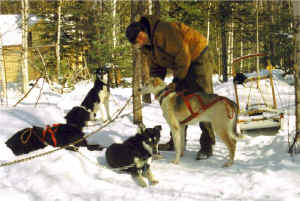
What size kennel do you operate?
We try to keep our kennel as small as possible, because we like to spend lots of
time with each individual dog. Currently we have 14 running dogs and a great neighbor who
let’s us use his dogs.
What type of tether/bowl system do you use?
Our dogs are tied up on 8 foot chains. The last foot of each chain overlaps with
the next, so that the dogs can play with each other. (Of course we don’t tie the
males right next to the females...) The chains are on metal stakes - whatever we can find
at the dump. They have to be long enough to pound them a few feet in the ground and stick
out at least four feet off the ground and stiff enough that an active dog can’t bend
it.
What are the most important considerations in housing sled dogs?
Although the dog houses have insulated floors, the dogs truly enjoy fresh
straw. My lead dog, Pompey, who is always keen to go on a run, would not come out of his
house if he just got fresh straw. The dog yard is out of the wind and all the houses face
the north side to give them shade in summertime. They have flat roofs to sit and sleep on.
Give us an overview of your feeding program.
We feed 50% a 30/20 dog food and 50% fresh meat (preferably with lots of liver,
hearts, pig tongues or beaver, depending what we can get) or boiled fish with wild rice.
Summarize your basic kennel management style.
Management? Hmmm.... never thought of it. I just go out every day and do the
necessary things like cleaning the dog yard, feeding, playing and in winter, running.
What breed(s) do you work with?
The dogs are all Alaskan Huskies.
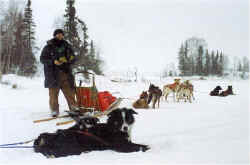 What
physical characteristics do you look for in your dogs? What
physical characteristics do you look for in your dogs?
Since we do lots of winter camping a thick undercoat is important to us, as are
tough feet. In warmer weather overheating can become a problem. So we are looking for the
dog that feels comfortable sleeping outside in minus 30 degree C, but doesn't start having
difficulties at minus 5. (To be honest: We are still looking, because we are not sure how
to find such a dog. Meanwhile we are happy with what we have.)
What mental or emotional attributes do you require in your dogs?
The dogs must be able to trust me. This way I am able to trust them as well. A dog
that feels secure doesn't quit on you, he'll run whenever you want him to go.
Communication between dogs and musher is a very important factor. It takes a smart dog to
learn the ‘people’ language. (And a smart musher to learn the dogs language.)
Tell us about an all time favorite dog or two.
I don’t want to bore you with another Look-how-great-my-lead-dog-is-story, so
I tell you about Piranha. She easily gets sidetracked. And she isn't the hardest working
dog in the team either. But she never forgets to wag her tail, if you give her a pat or
call her name. She cuddles up with the dog next to her on rest breaks and makes the dogs
around her feel good. She has a terrible crooked nose and looking at her will make me feel
good, too (or at least laugh).
What criteria do you use for selecting breeding
stock?
A friend saying: “I have this litter of puppies. It’s an
‘oops’ you want them....”
Do you use any pre-training evaluation of puppies?
We usually don’t take more than two puppies at a time. And they will
be sled dogs. With just two new dogs introducing in your team, you'll have time to figure
out what makes them work.
What method do you use for starting pups?
I start by teaching them easy commands when they are only a few months old. Like:
Sit, Stay and most important: NO. This will make it easier to teach them commands later
on. When they are old enough to be tied up, they can see the adults leaving the yard and
feel the excitement in all the running dogs. The first time in harness they run right away
with a small team of adult dogs and are usually pretty excited themselves.
What is the most important thing you look for in a young dog?
Eagerness to please (the trait in a dog that every cat owner despises). I
want a dog that gets excited when I praise him for doing something right.
At what point do you decide a youngster is likely to make it in
your team?
When I see him the first time. The more difficult questions is: At what
point do I decide he is not going to make it in my team.
What is the training/racing
philosophy of your kennel?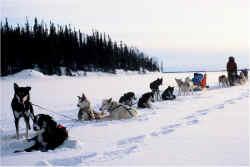
Go out and have fun! Lot’s of it.
Do you have specific training goals for your team(s)?
I want all dogs to be ‘honest’ workers. If I see a dog taking a
break during the run, I don’t want to have to remind that dog to start pulling again
after a short while. I also don’t want a dog that never takes a break unless you
stuff him in the basket.
What do you consider most important to accomplish in training?
To have a team that listens well. Ideally the leaders stay strung out, no
matter what might side track them, they rest if I tell them to and are ready to go not
when I pull the hook, but when I give the command.
What is the most indispensable training equipment you use?
A bag full of dog treats.
How do you choose which races to enter?
If the race follows a challenging wilderness course and is affordable to
get to. (One exception: The Lakeland Invitational Dog Derby which is a fun race in early
season and a social event to sit around and brag about your best team ever.)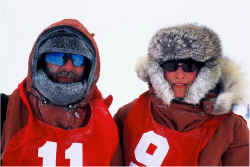
What are your strengths as a racer?
I watch my dogs performance very closely and don’t push them over
their limit.
What do you consider your weaknesses, if any?
I start a race with dogs that should be couch potatoes (like Piranha) and
not racing dogs.
Do you have a mushing career goal?
I hope I will find sponsors to be able to enter the races in the far, far
north (like the Kobuk 440).
What does it take to win?
A well conditioned team, that is as excited as you to be at the top.
What is your vision of the future of sled dog
sports?
My vision would be a greater focus on 6 or 8 dog mid and long distance
classes, so that you don’t have to have a huge dog yard to be competitive, which
makes the sport more affordable to a broader spectrum of mushers.
What can individual mushers do to support and promote the sport?
Present themselves as responsible animal owners, that take genuine care of
their dogs.
What part do clubs and organizations play in sport development?
Without them there would hardly be any races, forums and exchange in the
mushing world.
What advice would you give a beginning musher?
Read Judy Bergemann’s article "Caution! Sled Dogs are addictive" If you still want to
become a musher after reading the article, don’t think of all the great races you
could go to, think about if you are a dog-person. Respecting the dogs you work with is the
very first and most important step to get a good team. The second one will be to find a
good mentor, an experienced musher you can ask all the questions you have before getting
dogs and in the first years.
Tell us about one or two of your most memorable
sled dog experiences.
When I was asked how I choose which races to enter, I answered, races with
a challenging wilderness trail. There was one time though, were it was a little bit too
much wilderness for my taste, but luckily I didn't know:
During the Hudson Bay Quest 2006 when night was falling I pushed really hard to get to
the next checkpoint. I had hoped to get the dogs out of the wind and find some shelter
myself. The checkpoint turned out to be nothing more than a red flag in the ice. The
checkpoint volunteers welcomed me, waited for the last team to come in and then asked me:
“What time are you leaving?” I answered at sunrise. “Okay, we will be back
then to take your time.” With that they disappeared into the night. I was wondering
where they went to since the next community was still 100 miles away. The next morning
they were back in time. I asked them: “Where did you go last night?” -“Oh,
we went a few miles further inland. Where you camped, it’s too close to the floe
edge. We saw fresh Polar Bear tracks all over here. Way to dangerous to camp here.”
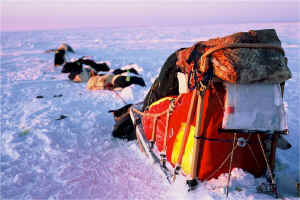
If you have any further questions or a looking for a mentor, you are
very welcome to contact me.
~ Go to more photos~
[back to Interview list]

top of page |
home |
feedback | search

|



